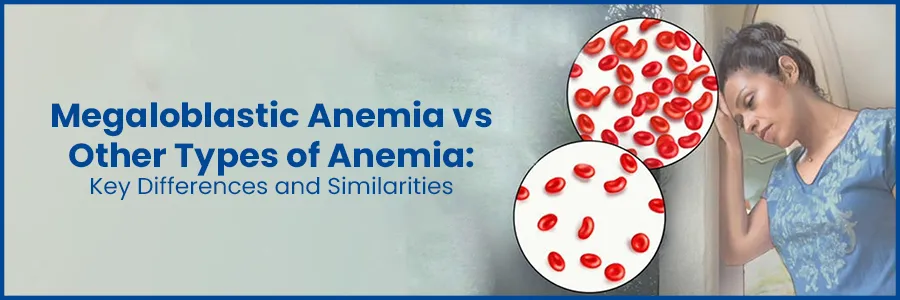- Cardiology 84
- Dermatology 45
- Endocrinology 33
- ENT 16
- Fertility 190
- Gastroenterology 78
- General-Medicine 81
- Gynecology 80
- Hematology 19
- Infectious-Diseases 33
- Neurology 52
- Oncology 34
- Ophthalmology 23
- Orthopedics 69
- Pediatrics 31
- Procedure 23
- Public-Health 144
- Pulmonology 59
- Radiology 8
- Urology 68
- Wellness 161
- Woman-and-child 77

Megaloblastic Anemia vs. Other Types of Anemia
Anemia is a common medical condition characterized by a deficiency of red blood cells (RBCs) or hemoglobin, leading to reduced oxygen-carrying capacity and a range of symptoms.
While there are various types of anemia, one distinct category is megaloblastic anemia. In this blog, we will delve into megaloblastic anemia and compare it to other types of anemia, highlighting the key differences and similarities among them.
Understanding Anemia
Anemia occurs when the body lacks healthy red blood cells to carry the required amount of oxygen to the tissues. This can lead to fatigue, weakness, paleness, shortness of breath, and other symptoms.
The various types of anemia can be classified based on their underlying causes, including nutritional deficiencies, genetic factors, chronic diseases, and more.
Megaloblastic Anemia: Causes and Characteristics
Megaloblastic anemia is a specific type of anemia characterized by the presence of unusually large and immature red blood cells.
This enlargement of RBCs, known as megaloblasts, is primarily caused by deficiencies in two essential nutrients: vitamin B12 (cobalamin) and folic acid (folate).
Both of these nutrients are crucial for the synthesis of DNA, which is necessary for normal cell division and maturation, including the production of red blood cells.
Key Characteristics of Megaloblastic Anemia:
- Enlarged and immature red blood cells (megaloblasts).
- Often affected by vitamin B12 or folic acid deficiency.
- May lead to neurological symptoms due to nerve damage (in cases of vitamin B12 deficiency).
- Megaloblastic anemia treatment involves addressing the underlying nutritional deficiency through supplements or dietary changes.
Comparison with Other Types of Anemia
- Iron-Deficiency Anemia: The most common type of anemia worldwide, it occurs due to insufficient iron, which is essential for the production of hemoglobin—the protein that carries oxygen in red blood cells.
Key Differences of Iron-Deficiency Anemia:
- Iron-deficiency anemia leads to small, pale red blood cells.
- Megaloblastic anemia results in large, immature red blood cells.
- Iron-deficiency anemia can be affected by blood loss, poor dietary intake, or malabsorption.
- Megaloblastic anemia causes are primarily deficiencies in vitamin B12 or folic acid.
- Hemolytic Anemia: This type occurs when red blood cells are destroyed faster than they are produced, due to inherited conditions, autoimmune reactions, or other factors.
Ready to take control of your health journey? Book your appointment now and start your path towards wellness today!
Book an AppointmentKey Differences of Hemolytic Anemia:
- Hemolytic anemia involves the premature destruction of red blood cells.
- Megaloblastic anemia results from impaired DNA synthesis and abnormal cell maturation.
- Hemolytic anemia has various underlying causes, including genetic factors and autoimmune disorders.
- Megaloblastic anemia's primary causes are deficiencies in vitamin B12 or folic acid.
Anemia Treatment Doctors
Our team of anemia treatment doctors at Medicover includes board-certified hematologists, internists, and specialists in related fields.
Their expertise, coupled with their commitment to delivering compassionate care, makes them an invaluable resource for patients seeking effective management of megaloblastic anemia.
Conclusion
Anemia encompasses a range of conditions, each with unique underlying causes and characteristics. Megaloblastic anemia stands out due to its connection with deficiencies in vitamin B12 and folic acid, resulting in the formation of large and immature red blood cells. Understanding the differences and similarities between megaloblastic anemia and other types of anemia is essential for accurate diagnosis and appropriate treatment. If you suspect you may have anemia or are experiencing related symptoms, it's important to consult a healthcare specialist for proper evaluation and management.
Frequently Asked Questions
Megaloblastic anemia is a specific subtype characterized by enlarged and immature red blood cells, primarily caused by deficiencies in vitamin B12 or folic acid. Other types like iron-deficiency anemia and hemolytic anemia have different causes and distinct characteristics.
Megaloblastic anemia is mainly caused by deficiencies in vitamin B12 and folic acid, crucial for DNA synthesis and cell maturation. Without these nutrients, red blood cells can't divide and mature normally, leading to large and immature cells.
Symptoms such as fatigue, weakness, and pale skin are similar to other types of anemia. However, megaloblastic anemia may also cause neurological symptoms due to nerve damage from vitamin B12 deficiency, which is not typical in other types.
Treatment involves addressing vitamin deficiencies through supplements, diet changes, or injections. Other types have different treatments; for instance, iron-deficiency anemia is treated with iron supplements.
Yes, multiple types can coexist, especially with diverse underlying causes. For example, both megaloblastic anemia and iron-deficiency anemia may occur concurrently.
Anemia itself is a concern with various causes from nutritional deficiencies to chronic diseases. Consulting a healthcare provider is essential for proper diagnosis and treatment.
If experiencing symptoms like fatigue, weakness, and pale skin, consult a healthcare provider for tests to determine the type and cause of anemia and to discuss appropriate treatment options.

- Cardiology 2132
- Dermatology 168
- Endocrinology 135
- ENT 97
- Fertility 217
- Gastroenterology 232
- General 478
- General-Medicine 1685
- Gynecology 169
- Hematology 85
- Infectious-Diseases 208
- Neurology 207
- Oncology 345
- Ophthalmology 65
- Orthopedics 187
- Pediatrics 83
- Procedure 72
- Public-Health 209
- Pulmonology 126
- Radiology 13
- Second Opinion 311
- Urology 294
- Wellness 600
- Woman-and-child 447
- Others 10217
Related Blogs
If you have any questions, please fill out the enquiry form or call us, and we will get back to you promptly.
040-68334455